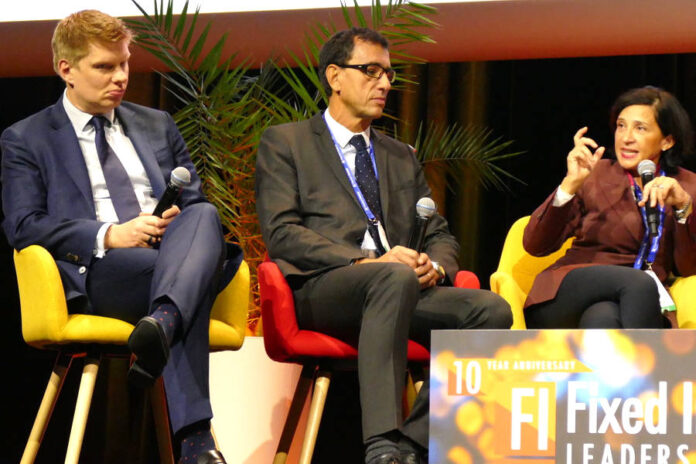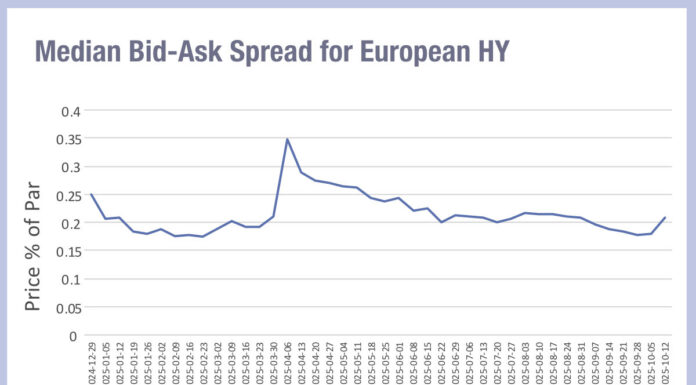Amid swirling geopolitical uncertainty, are bond portfolios recession-proof? This was the question debated by buyside panellists at the Fixed Income Leaders Summit on Friday.
For three of the largest fixed income managers in the world, central bank policies dominated the conversation.

“The good thing is that central banks have the capacity now, they are much more proactive, that it almost seems to be as if recessions are not allowed” said Iain Stealey, CIO global fixed income, currency and commodities at JP Morgan Asset Management. “Jerome Powell is obsessed about having a soft landing – what’s not to like about this stage of the cycle?”
However, the benign mood about central bank easing did not apply to the longer end of the yield curve, others warned. “Markets have been focusing only on one thing – the short end of the curve”, said Olivier De Larouzière, CIO, global fixed income at BNP Paribas Asset Management. “Let’s talk about the balance sheet of central banks. Is this normalized? Clearly far from it. Is there still room for steepening, which was the most consensual trade across the globe? I think so”.

According to Larouziere, there was still massive distortion in longer maturities because of looming uncertainty over the fate of central bank bond holdings, which made it hard for private sector investors such as BNP Paribas Asset Management.
“At the longer end, the focus is on size of debts, sustainability of debts and credibility. There’s a very high-risk geopolitical environment, and central bankers are the safety net. It has been a huge limitation to what we can do in response to their natural offer and demand”.

Meanwhile, fixed income investors had their own balance sheet challenges. This was true particularly the insurance industry, which had to juggle solvency regulations and the risk of life insurance policyholders cashing in – triggering ‘lapses’ of insurer liabilities, according to Anna Maria Reforgiato Recupero, CIO of insurance regions at Assicurazioni Generali.
“There was a tsunami that we started in experiencing industrywide, in an acceleration of the lapses,” she said.
Refortiato Recupero explained that a reduction in policyholder liabilities necessitated the selling of bond assets – forcing insurers to lock in mark-to-market losses that affected their regulatory solvency ratios.
“We clearly needed to start unwinding the portfolio that created a number of distortions of the Solvency Capital Requirement (SCR) and so on”.
“Your ability to generate cash and adapt to the liability makes a difference”, she added. “What we have learned from this environment is that asset-liability management (ALM) discipline is number one, because that’s what will help you and save you in terms of vulnerability in the portfolio, not necessarily the level of rates but in the speed of change.”
JPMAM’s Stealey tried to reassure panellists that central banks would keep rates stable, and volatility low.
“Given the central banks believe they’ve got inflation under control, and the direction of travel is now back towards easier policy, I actually think the scope for big directional moves should decrease”, he said.
Reaching for yield
Finally, the panellists noted that steepening yield curves were prompting investors to switch from cash to higher-yielding assets such as credit, with inflows also dampening volatility.
“Since the Fed’s cut, there’s been money piling into credit funds” Stealey said. “Even if a manager doesn’t like credit, as long as people are investing in general bond funds, every single day, we’re buying credit, because we need to keep up with those inflows that are coming in.”
With rates still at relatively high levels, fixed income managers can reap the harvest on their bond positions, and potentially boost it further with leveraged carry trades.
“It can seem like bad news. You know, no direction, no opportunities”, said BNP’s Larouziere. “What we have in fixed income, is one of the easiest jobs in the world, because carry is back. Not only fixed income is back, but carry is back with a reduction in volatility, this is good news”.
“We are obsessed by yield pickup”, said Refortiato Recupero, explaining how she used derivatives and inflation-linked bonds to boost returns in order to match Generali’s insurance liabilities. Targeted accrual redemption notes (TARNs) were also being used by Generali to add yield.
She concurred with Stealey on the benign environment – but with caveats.
“Our house view is still a soft-landing scenario, quite benign. What might have increased are the potential downside risks”, she said, referring to the US presidential election.
©Markets Media Europe 2024
©Markets Media Europe 2025










